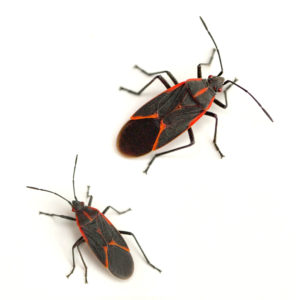Boxelder Bugs
The spring season is rapidly approaching, and while it brings beautiful days and warm weather to Georgia, it is also notorious for bringing a variety of pests along as well. Recently, we have received calls from homeowners who report finding clusters of tiny, red bugs around pine straw or mulch. Often when these areas are disturbed they reveal thousands of the red bugs swarming beneath. These are often misidentified as ticks, but typically these pests are in fact boxelder bug nymphs.

Boxelder bugs are a type of beetle. They are common throughout most of North America, and are particularly prevalent in the warm climates of the Southeast. The red bugs that many homeowners find are the developing nymphs. Their presence is a sign of an active population of adult boxelder bugs. The adult boxelder bugs are much larger than the nymphs, growing to around 1/2 an inch in length. They are black in coloration and have distinct orange or red stripes on their bodies. While the nymphs are frequently found nearer to the ground, the adults will often be found on trees or on the exterior of the home.
True to their name, boxelder bugs will feed on the boxelder tree, consuming the soft parts of the tree such as the stems, leaves, and flowers. This causes little damage to the tree in small amounts, however larger populations can cause branch growth defects and a yellowish discoloration on the leaves.
The lifecycle of boxelder bugs begins in the springtime, when the female boxelder bugs lay eggs inside of the bark of trees. These eggs hatch within a few days and release the nymphs, who grow into adulthood during the summer. During late autumn, the boxelder bugs will mass around the outsides of homes or other buildings and attempt to find an access point to enter into the home. They do this because they are naturally attracted to the warmth from inside of the home, and will frequently take advantage of any exterior damage, open vents, or unsealed windows or doors to gain entry into the home.
Once inside, the boxelder bugs will seek out the warmest areas of the house, and homeowners are often caught off guard by the sudden influx of the pests inside of their home. While they can often appear in very large populations, it is important to note that the boxelder bugs do not reproduce or eat during this time, and are instead simply using the home as a way to survive the cold weather. This is not particularly reassuring, however, because they are still unwelcome guests in the home and can number in the thousands in some cases.
If they survive the winter, they will emerge during the spring and will frequently gather on the sunlight exterior walls of the home, where they are frequently found by homeowners. They will then seek out boxelder, maple, or ash trees to feed upon and lay eggs to restart the cycle once again.
Treating boxelder bugs can be a difficult process. Although they are susceptible to chemical pesticides, carelessly killing the populations inside or near to homes can leave behind large amounts of dead boxelder bugs, which can become an attractive food source for other pests such as ants or wasps.
The best method for dealing with boxelder bugs is to make sure that they cannot enter into your home during the winter. Several steps that can assist in this include:
- Properly screen all vents and crawlspaces
- Seal all windows and doors
- Repair any exterior damage to the home
- Avoid planting any boxelder trees in close proximity the home
These steps can help to prevent the boxelder bug population from continuing through the winter, and are also helpful for preventing other pest problems as well. If you choose to plant boxelder trees around your home, you can lower the risk of infestation by planting only the male trees, which are much less likely to be fed upon.
If you are dealing with a population of boxelder bugs on your property, it can often save you a lot of time and frustration if you call a professional service. Our team at Canton Termite and Pest Control has years of experience dealing with pests of all kinds. Our technicians can assess the situation in and around your home and implement the most efficient, safe, and fast-acting solutions to solve any pest problem once and for all!
So if you need real solutions for your pest problems, call us today at 770-479-1598! We will happily help in any way that we can!
By: Tim
